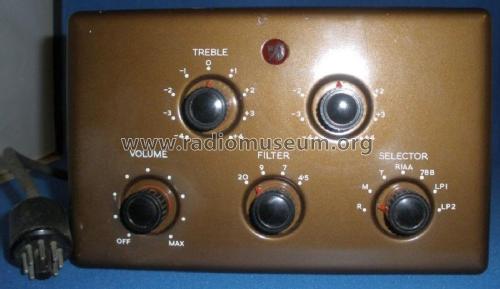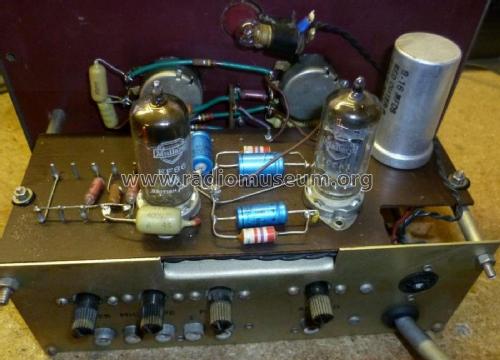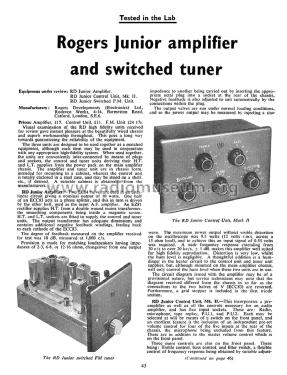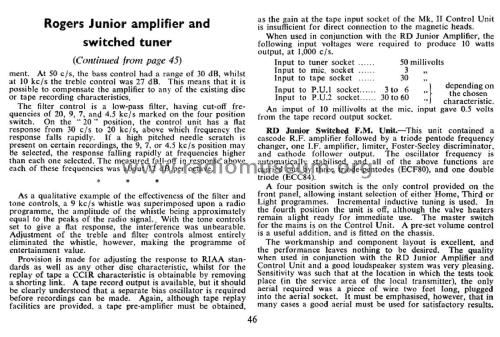RD Junior Control Unit Mk II (2)
Rogers, Catford (see also Rogers Birmingham)
- País
- Gran Bretaña (GB)
- Fabricante / Marca
- Rogers, Catford (see also Rogers Birmingham)
- Año
- 1954 ?
- Categoría
- Amplificador de audio o mezclador
- Radiomuseum.org ID
- 357236
- Numero de valvulas
- 2
- Principio principal
- Amplificador de Audio
- Gama de ondas
- - no hay
- Tensión de funcionamiento
- Alimentado desde otro equipo o aparato principal.
- Altavoz
- - Este modelo usa amplificador externo de B.F.
- Material
- Metálico
- de Radiomuseum.org
- Modelo: RD Junior Control Unit Mk II - Rogers, Catford see also
- Forma
- Chasis (tambien de autoradio)
- Ancho, altura, profundidad
- 8.5 x 5.125 x 4.875 inch / 216 x 130 x 124 mm
- Anotaciones
-
The RD Junior Control Unit Mk II (2), reviewed in the March 1959 issue of Gramophone UK Magazine, was an evolution of Rogers' original Junior control unit introduced in 1952. The Mk 2 version, released in 1953, featured significant improvements over its predecessor. This versatile preamplifier incorporated all necessary controls for an audio amplifier and offered five input options: Radio, microphone, tape replay, P.U.1, and P.U.2. A front panel switch allowed easy selection between inputs. A notable feature was the inclusion of independent pre-set volume controls for four of the five inputs (excluding microphone) located on the rear chassis, in addition to the master volume control on the front panel.
The front panel housed three additional controls:
- Treble control (27 dB range at 10 kHz)
- Bass control (30 dB range at 50 Hz)
- Filter switch (low-pass filter with cut-off frequencies at 20, 9, 7, and 4.5 kHz)
This flexible control scheme allowed for compensation to various disc or tape-recording characteristics. The filter control was particularly effective in reducing high-frequency noise, with a measured fall-off of about 12 dB per octave above the selected frequency. The unit provided RIAA equalization for disc playback and CCIR equalization for tape replay (via a removable shorting link). While a tape record output was available, it's important to note that a separate bias oscillator was required for recording. Similarly, tape replay required an additional preamplifier due to insufficient gain at the tape input socket. When paired with the RD Junior Amplifier, the control unit demonstrated the following input sensitivities to produce 10 watts output at 1 kHz:
- Tuner: 50 mV
- Microphone: 3 mV
- Tape: 30 mV
- P.U.1: 3-6 mV
- P.U.2: 30-60 mV
Additionally, a 10 mV input at the microphone socket yielded 0.5 V at the tape record output.
- Mencionado en
- -- Original-techn. papers. (Tape Recording UK Mar 1959, Page 45 & 46.)
- Autor
- Modelo creado por Gary Cowans. Ver en "Modificar Ficha" los participantes posteriores.
- Otros modelos
-
Donde encontrará 39 modelos, 39 con imágenes y 6 con esquemas.
Ir al listado general de Rogers, Catford (see also Rogers Birmingham)



